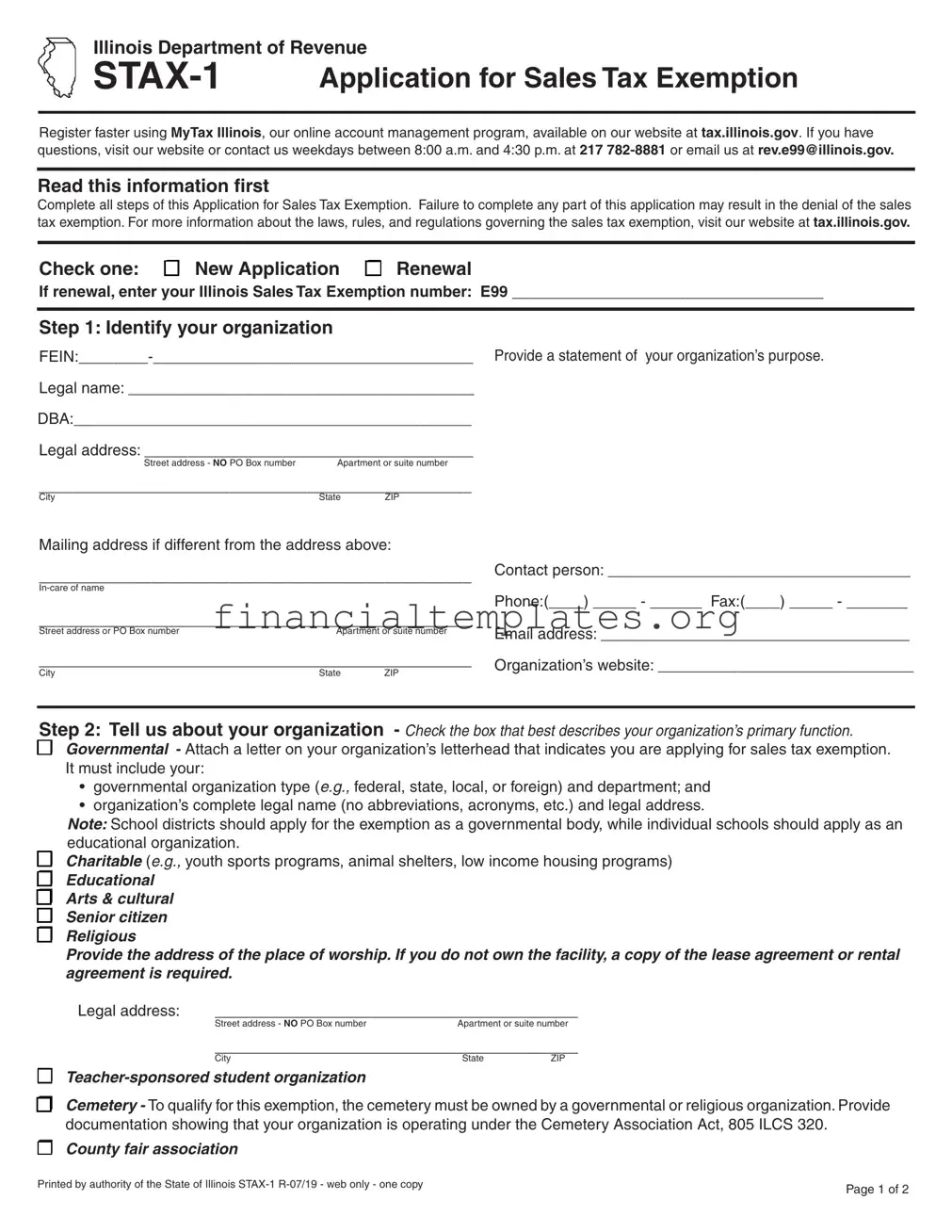The Form 1023, Application for Recognition of Exemption Under Section 501(c)(3) of the Internal Revenue Code, bears a striking resemblance to the STAX-1 form in several aspects. Both forms are pivotal for organizations striving to secure tax-exempt status, albeit under different jurisdictions; the STAX-1 for Illinois state sales tax exemptions and the Form 1023 for federal income tax exemptions. Each form necessitates comprehensive organizational details, such as legal name, address, and a statement of purpose. Additionally, they require attachments that describe the organization's activities, governance documents, and a certification that the application is complete and accurate to the best of the applicant's knowledge.
The SS-4 Form, Application for Employer Identification Number (EIN), is akin to the STAX-1 form in that both are initial steps for newly formed organizations setting their foundational compliance structures. While the SS-4 is focused on securing an EIN necessary for tax identification purposes at a federal level, the STAX-1 addresses state-specific sales tax exemption requirements. Each form requires basic identifiers like legal name, address, and contact information. However, the SS-4 emphasizes tax identity, and the STAX-1, tax exemption status.
Similarly, the Business License Application forms that various states offer share common ground with the STAX-1 form. These forms typically serve as a gateway for entities to legally operate within a state, encompassing a wide range of activities from sales to services. Like the STAX-1, state business license applications demand organizational details and the nature of the entity's activities. Both forms are crucial for compliance with state regulations, albeit serving different regulatory functions—one for licensing and the other for tax exemption.
The Form 990, Return of Organization Exempt from Income Tax, also parallels the STAX-1 form to a certain extent. Though the Form 990 is an annual filing for organizations to maintain their federal tax-exempt status, and the STAX-1 is an application for state sales tax exemption, both require detailed disclosures about the organization's operations, finances, and governance. Organizations must provide a narrative of their mission and activities, which is essential for both maintaining federal tax-exempt status and obtaining state sales tax exemptions.
The Charitable Organization Registration Form, required by many states' attorneys general, shares objectives similar to those of the STAX-1 form. It's designed for charitable entities to gain authorization to solicit donations within a state. Both forms necessitate detailed information about the organization, its purpose, and its activities. However, the focus diverges; the STAX-1 is tailored for sales tax exemption, whereas the charitable registration targets fundraising legality.
Unemployment Insurance registration forms, mandated by state employment departments, also resemble the STAX-1 form but cater to a different domain of organizational compliance. These forms ensure organizations contribute to the state's unemployment insurance fund, capturing organizational details similar to those on the STAX-1. Despite their different aims—one for tax exemption and the other for unemployment insurance—both are critical for operational legality in their respective areas.
The application for State Environmental Quality Permits often necessitates a detailed description of an organization’s operations similar to the STAX-1 form. Though primarily concerned with environmental impact and compliance, these applications require organizations to submit detailed information about their activities, premises, and purpose, analogous to the documentation required for sales tax exemption. The focus on regulatory compliance underlines the similarities between these forms.
The Zoning Permit application, another document with objectives that coincide with the STAX-1 form, is crucial for ensuring that an organization’s physical location and operations comply with municipal land-use regulations. Like the STAX-1, zoning permits require detailed information about the organization's premises and activities. While zoning permits focus on land use and structure, the STAX-1 focuses on tax exemption, yet both serve as essential compliance steps for organizations.
Corporate Income Tax Returns, while primarily focused on reporting income, expenses, and paying corporate income tax, demand detailed organizational and operational information akin to what is required on the STAX-1 form for sales tax exemption. Organizations must supply specifics about their identity, nature, and activities, underlying the commonality of requiring thorough organizational disclosures for compliance purposes, regardless of the tax-specific objective.
Finally, the Worker’s Compensation Insurance forms, necessary for organizations to comply with state laws regarding employee injury compensation, bear similarity to the STAX-1 form in requiring organizational details. Although their primary aim is to ensure coverage for workplace injuries, these forms, like the STAX-1, collect essential details about the organization, marking another intersection of compliance-focused documentation across different regulatory areas.


